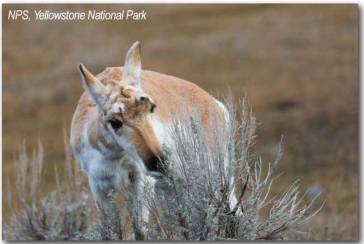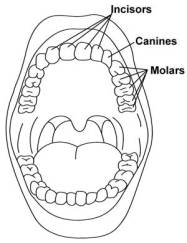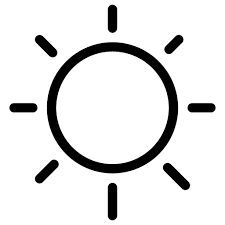Question answered by Dr. Jericho Whiting, Biology Professor, BYU-Idaho
Sagebrush provides a ready source of winter nutrition for pronghorn, because of its nutritional quality and relative availability on sagebrush-dominated winter range used by these ungulates.
 Three adaptations by pronghorn allow them to eat sagebrush in winter. First, pronghorn are opportunistic herbivores. As such these animals are able to feed on grasses, forbs, and shrubs. This adaptation allows them to feed on small amounts of a wide variety of plants in winter. For example, one study in seven western states indicated that in over 900 stomach samples from pronghorn the average amount of browse (shoots, twigs, and leaves of shrubs) was 64%, of which 73% was sagebrush. Another study in Montana documented that the winter diet of pronghorn consisted of 78% shrubs (45% of which was sagebrush), 19% forbs, and a small amount of grasses.
Three adaptations by pronghorn allow them to eat sagebrush in winter. First, pronghorn are opportunistic herbivores. As such these animals are able to feed on grasses, forbs, and shrubs. This adaptation allows them to feed on small amounts of a wide variety of plants in winter. For example, one study in seven western states indicated that in over 900 stomach samples from pronghorn the average amount of browse (shoots, twigs, and leaves of shrubs) was 64%, of which 73% was sagebrush. Another study in Montana documented that the winter diet of pronghorn consisted of 78% shrubs (45% of which was sagebrush), 19% forbs, and a small amount of grasses.
Second, pronghorn are selective browsers with elongated heads and pointed mouth parts that allow them to forage on stems and leaves of new growth, high-protein plant parts with lower concentrations of plant secondary compounds.
Finally, pronghorn may have a higher digestive efficiency than other ungulates that occupy the same ranges in winter. This is because pronghorn evolved in North America, which has allowed these ungulates to avoid or neutralize the antidigestive and toxic effects on secondary compounds in North American plants more so than other ungulates that arrived later to North America, such as bighorn sheep.
Literature cited:Bayless, S. R. 1969. Winter food habits, range use, and home range of antelope in Montana. Journal of Wildlife Management 33:538-551.
Beck, J. L., J. W. Connelly, and C. L. Wambolt. 2012. Consequences of treating Wyoming big sagebrush to enhance wildlife habitats. Rangeland Ecology and Management 65:444-455.
Byers, J. A. 2003. Pronghorn. In Wild Mammals of North America: Biology, Management, and Conservation; Feldhamer, G. A., Thompson, B. C., and Chapman, J. A. (editors). The John Hopkins University Press, Baltimore
Grazers and Browsers
Grazing animals feed primarily on grass. Grazers, such as cows and sheep and bison, tend to have relatively broad muzzles so that they can chomp up large clumps of grass in one bite.
A browsing animal, on the other hand, feeds on leaves, stems and buds. Leaves are mixed in with woody twigs. Wood is indigestible, so browsers are picky, aiming for the leaves, stems and buds. Because of this, browsers like deer or pronghorn tend to have a narrower head than a grazer.
 Teeth
Teeth
All mammals have teeth that are adapted to eating certain types of food. Herbivores, because they are plant eaters, have strong and flat molars that are made for grinding leaves and small or non-existent canine teeth. Carnivores, the meat eaters, have very defined canine teeth for tearing at meat, combined with a sometimes limited number of molars. Omnivores, because they eat meat and plants, have a combination of sharp front teeth and molars for grinding.
We are omnivores. We don’t usually think about which teeth we are using when we chew our food, but during this activity pay close attention to how your teeth help you to eat different kinds of food.
Materials: carrots, celery, apple, popcorn, pretzels, nuts, dried fruit, jerky
Can you predict what teeth you would use for other foods?
Share this:




